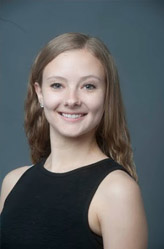BA in Dance and BA in Environmental Studies, Minor in Psychology
“Limitless”

My creative project merges elements of both modern dance and classical ballet through a dance performance piece titled “Limitless“. In the summer of 2015, my studies at Maryland Youth Ballet gave me the opportunity to take professional dance classes in ballet and pointe. Alternatively, while at UMBC, my primary focus has been to learn modern dance methods, e.g., Graham, Horton, and Limon. Classical ballet has its origins in the 18th and 19th centuries, emphasizing elegance, beauty, and regimentation, and has a choreographic process directly related to a musical score. Modern dance, a product of the 20th century, is often abstract and uses a wide variety of choreographic processes not linked to the musical score. Combining these varied techniques has been a personal challenge and a pursuit of self-exploration. In creating this piece, I emphasized beauty as a classical ballet choreographer, while using choreographic methods commonly found in modern dance. My work in progress piece, Limitless, is the culmination of this creative process combining modern dance with classical ballet. The intention of this fusion of styles into one piece is to motivate others to embark on their own exploration of movement modalities to create one that is uniquely their own.
How did you find the research opportunity?
Through the Dance Department Summer Research and Study Award, I was able to attend a summer intensive program at the Maryland Youth Ballet that allowed me to research what I wanted, in dance, for my URCAD project. I researched the fundamentals of ballet and modern dance, and created a project on the combination of both.
Who is your mentor for your artistic project? How did you arrange to work with this person?
Doug Hamby in the Dance Department; He has been my teacher and advisor while at UMBC, and he has helped me with previous research and projects in my dance classes.
Do you get course credit for this work? Paid? How much time do you put into it?
No, I do not get credit or get paid for this work. It takes a while to choreograph a dance piece. I have taken numerous classes and workshops to create a piece that shows the culmination of my research in ballet and modern techniques. Sometimes it can take hours to create just 20 seconds of a dance piece, in order to get exactly what you want to present to an audience.
What was the hardest part about your research?
Finding ways to combine Ballet and Modern Dance, in a way that can relate to all audience members, whether they know a lot about dance or not.
What was the most unexpected thing?
Both styles of dance (ballet and modern) have a lot in common. Many movements I made for this research are a product of both styles, and combining the two allowed me to use a greater range of motion than when I just used one style.
How does this research experience relate to your work in other classes?
Throughout my years at UMBC, I have been exposed to many different styles of modern dance, such as Graham, Horton, and Limon techniques. I have also taken many ballet classes throughout my UMBC career, and all throughout my life. Modern dance was new to me in college, and I have combined many things I have learned in classes to what I previously knew, and this has helped me improve as a dancer.
What are you involved in on campus?
I am a Linehan Artist Scholar, and I am also the Secretary of the Dance Council of Majors.
What else are you involved in?
I teach dance to younger students at the dance studio where I grew up. Teaching to others allows me to share my passion for dance and pass on what I have learned. I am also a professional soloist with the Howard County Ballet. I have been dancing with this company since my freshman year of college.
9/8/2021